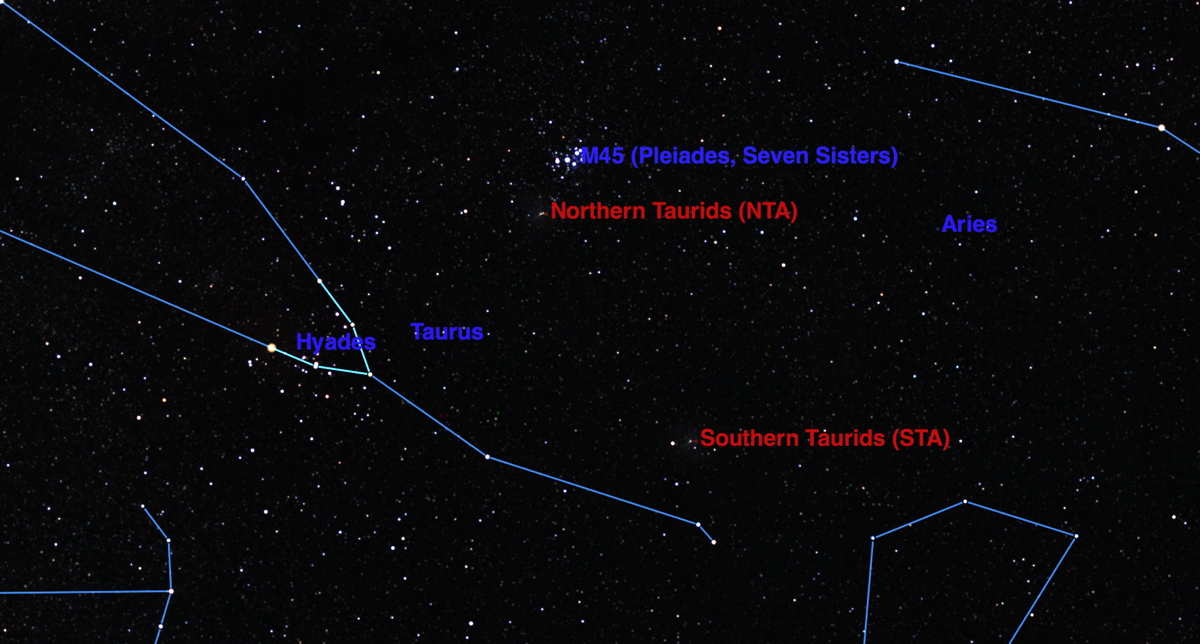Fireballs from Taurus: See the Taurid Meteors This Week

Meteors, popularly called "shooting stars," are much more common than most people think. In fact, there's a display going on now - courtesy of two Taurid meteor showers - if you know when and where to look.
Meteor showers are made up of brief-lived streaks of light caused by small particles traversing the Earth's atmosphere and heating it to incandescence. In space these particles are called "meteoroids." If they survive their trip through the atmosphere to reach the surface of the Earth, they are called "meteorites." It is only while they are in transit through the air that they are called "meteors."
Most meteoroids are quite small, from the size of a pebble down to the size of a grain of sand. They are found throughout the solar system, so the Earth encounters many of them every day. It is estimated that the Earth sweeps up 15,000 tons of meteoroids each year, or 40 tons each day. [How Meteor Showers Work (Infographic)]
The result is that on any dark clear moonless night of the year, if you go out after midnight and let your eyes acclimatize to the dark, you are almost guaranteed to see at least a few meteors.
At various times during the year, the Earth passes through parts of its orbit which are richer in meteoroids. Because these are parts of streams of material, usually left over from past comets, the dates of these showers of meteors are easily predicted.
See the Taurid meteor showers
At present, and for the next two weeks, we are passing through a stream of meteoroids derived from Comet Encke, or possibly a much older larger comet which spawned both Encke and the meteoroids.
Because these meteor streams lie along an elliptical orbit around the sun, when we watch them they appear to come from a particular part of the sky, in this case the constellation Taurus, and hence are named the Taurids. The point in the sky that they radiate from is called the "radiant."
Breaking space news, the latest updates on rocket launches, skywatching events and more!
The Taurids are a particularly large collection of meteoroids, so the Earth takes several weeks to pass through them. They are also made up of unusually large particles, so while they are relatively few in number on a given night, they cause a disproportionate number of very bright meteors, which astronomers call "fireballs."
Because the Taurids last for several weeks, they have been divided into two separate showers because their radiant moves during that time. The "South Taurids" peak on Thursday (Nov. 5), and the "North Taurids" peak a week later on Thursday (Nov. 12).
Visible all night
While more meteors are usually seen after midnight, when Earth's facing edge is heading into the meteor streams, Taurids can be seen at any time of night because their radiant is high overhead most of the night.
As you can see in the chart, the South Taurids appear to radiate from a point in southern Taurus, close to Omicron and Xi Tauri. The North Taurids radiate from close to the Pleiades, the brightest star cluster in the night sky. The meteors themselves can be seen anywhere in the sky, and it is only by tracing their motion backwards that you can determine which type of Taurid they are.
As always, if you do go out to look for Taurids, dress warmly, and lie back comfortably on a deck chair or something similar. Have patience, because these meteors are not frequent, but when they come, they are often spectacularly bright, and often leave smoke trails behind them.
If you want to try to photograph them, leave your camera's shutter open for at least 30 seconds at a time, and make many exposures. Most will be blanks, but you may get lucky and capture a Taurid or two.
Editor's note: If you capture a photo of a Taurid meteor that you'd like to share with Space.com and its news partners for a possible story or gallery, send images and comments in to managing editor Tariq Malik at spacephotos@space.com.
This article was provided to SPACE.com by Simulation Curriculum, the leader in space science curriculum solutions and the makers of Starry Night and SkySafari. Follow Starry Night on Twitter @StarryNightEdu. Follow us @Spacedotcom, Facebook and Google+. Original article on Space.com.
Join our Space Forums to keep talking space on the latest missions, night sky and more! And if you have a news tip, correction or comment, let us know at: community@space.com.

Geoff Gaherty was Space.com's Night Sky columnist and in partnership with Starry Night software and a dedicated amateur astronomer who sought to share the wonders of the night sky with the world. Based in Canada, Geoff studied mathematics and physics at McGill University and earned a Ph.D. in anthropology from the University of Toronto, all while pursuing a passion for the night sky and serving as an astronomy communicator. He credited a partial solar eclipse observed in 1946 (at age 5) and his 1957 sighting of the Comet Arend-Roland as a teenager for sparking his interest in amateur astronomy. In 2008, Geoff won the Chant Medal from the Royal Astronomical Society of Canada, an award given to a Canadian amateur astronomer in recognition of their lifetime achievements. Sadly, Geoff passed away July 7, 2016 due to complications from a kidney transplant, but his legacy continues at Starry Night.

